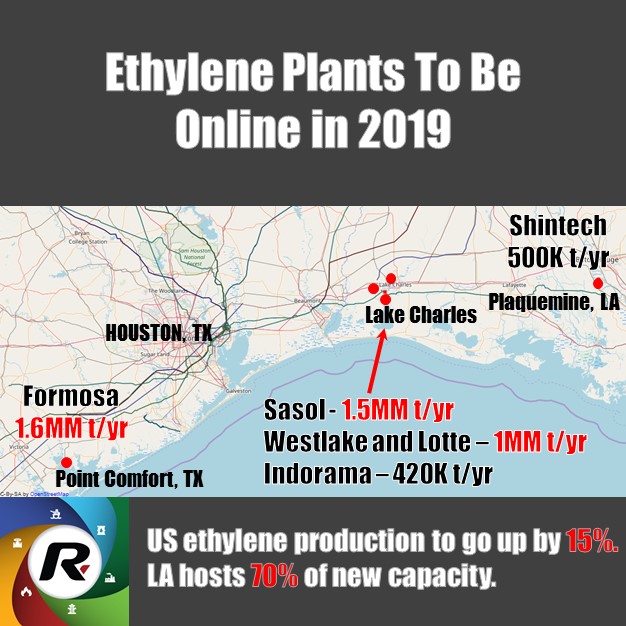Comprehensive Energy Data Intelligence
Information About Energy Companies, Their Assets, Market Deals, Industry Documents and More...
New Ethylene Facilities Going into Service in 2019
01/14/2019
New Facilities Scheduled to Go Operational as U.S. Ethylene Market Is on the Rise
Both on supply and demand side prospects for the NGLs market look bright. In particular, U.S. production is expected to grow by 15% in 2019. Most of the scheduled capacity will be paired with derivative units so spot prices will not be heavily affected.
Behind the expected output increase stand several key facilities, most of them to be completed in Louisiana.
The Number One hub for these projects is the Lake Charles area.
Indorama Ventures is about to complete its long-awaited 420,000 tonnes/year cracker unit. It will process ethane and propane feedstocks to produce 370,000 tonnes/year of ethylene and 30,000 tonnes/year of propylene. The facility, idled back in in 2001, was acquired in late 2015 from Occidental Chemical (OxyChem). It is currently in commissioning and should go operational early in 2019.
Sasol’s Lake Charles Chemical Complex consisting of seven manufacturing units situated on approximately 400 acres will have tripled the company's chemical production capacity once an ethane cracker with annual capacity of 1.5 million tonnes/year of ethylene will be put to service. Approximately 90 percent of the cracker's ethylene output will be converted into a diverse commodity and high-margin specialty chemicals. The cracker is reaching mechanical completion in December 2018.
Finally, Lake Charles petrochemical project, a JV by Westlake Chemical Corp. and Lotte Chemical USA Corp. (South Korea), will put in service an ethane cracker to produce more than 1 million-tonne/year of ethylene. The Lake Charles ethylene plant is scheduled for startup during first-quarter 2019.
Point Comfort, Texas
Formosa Plastics Corp. USA. is currently building a 1.6 million tonnes/year plant here. It is to begin operation in 2019.
Plaquemine, LA
Shintech Inc., the U.S. subsidiary of Shin-Etsu Chemical Co. Ltd., Tokyo, is building a 500,000 tonnes/year ethylene plant here.
The company had planned to reach mechanical completion by the end of 2018 and to begin start-up during the first quarter. The ethane cracker is part of an expansion planned to support feedstock for the company’s ethylene vinyl chloride (VCM) and polyvinyl chloride (PVC) production.
Information about other U.S. petrochemical facilities including NGL/LPG/HV pipelines can be discovered on Rextag’s U.S. Natural Gas Liquids Infrastructure maps.
If you are looking for more information about energy companies, their assets, and energy deals, please, contact our sales office mapping@hartenergy.com, Tel. 619-349-4970 or SCHEDULE A DEMO to learn how Rextag can help you leverage energy data for your business.
How Big Is U.S. NG Pipeline Network?
![$data['article']['post_image_alt']](https://rextag.com/images/public/blog/pipelines.jpg)
See how U.S. NG pipeline network length compares to that of other countries.
Pembina (PBA) to Acquire Enbridge's Joint Ventures for $2.3 Billion - C$3.1 Billion
![$data['article']['post_image_alt']](https://images2.rextag.com/public/blog/211Blog_Enbridge divests Alliance Pipeline and Aux Sable interests for 2.3B.png)
Pembina Pipeline Corporation PBA, a well-known player in the Canadian midstream sector, recently announced its plan to acquire Enbridge Inc.'s remaining shares in the Alliance Pipeline, Aux Sable pipelines, and NRGreen joint ventures. The deal, valued at C$3.1 billion or US$2.3 billion, marks a key step for Pembina in asserting its leadership in North America's natural gas transportation sector. This strategic acquisition is expected to considerably boost Pembina's growth and profitability in the coming years.
![$data['article']['post_image_alt']](https://images2.rextag.com/public/blog/328_Blog_Why Are Oil Giants Backing Away from Green Energy Exxon Mobil, BP, Shell and more .jpg)
As world leaders gather at the COP29 climate summit, a surprising trend is emerging: some of the biggest oil companies are scaling back their renewable energy efforts. Why? The answer is simple—profits. Fossil fuels deliver higher returns than renewables, reshaping priorities across the energy industry.
![$data['article']['post_image_alt']](https://images2.rextag.com/public/blog/327_Blog_Oil Market Outlook A Year of Growth but Slower Than Before.jpg)
The global oil market is full of potential but also fraught with challenges. Demand and production are climbing to impressive levels, yet prices remain surprisingly low. What’s driving these mixed signals, and what role does the U.S. play?
![$data['article']['post_image_alt']](https://images2.rextag.com/public/blog/326_Blog_USA Estimated Annual Rail CO2 Emissions 2035.jpg)
Shell overturned a landmark court order demanding it cut emissions by nearly half. Is this a victory for Big Oil or just a delay in the climate accountability movement?